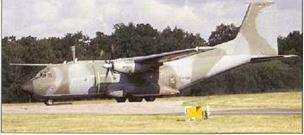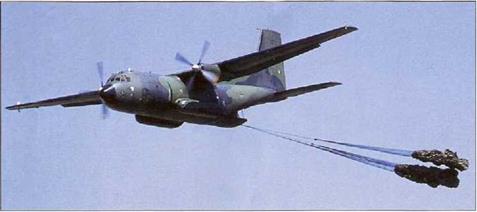Transall С. 160
|
|
T |
he Franco-German Transall C.160 was originally conceived as a Nord Noratias replacement and was one of the first successful joint European aerospace ventures. Of similar configuration to the C-130 Hercules, albet rather smaller and powered by a pair of Rods Royce Tynes, the Transall is robust, reliable anc enjoys excellent performance characteristics. Initial procurement comprised 50 C.160F aircraft for France anc HO C.160D aircraft for West Germany, The first of three prototypes made its maiden flight on 25 February 1963. Production-configured C.160s were delivered from 1967-72. Exports comprised nine C,160Zs for South Africa (now retired) and 20 C.160Ts (former Luftwaffe C.160Ds} for Turkey.
The production line was reopened in France in the late 1970s. The Armee de I’Air ordered 29 C.160IMG (Nouvelle Generation) aircraft which introduced additional fuel capacity, improved avionics and an IFR probe above the cockpit. Maximum payload is 16000 kg (35,275 lb), while 93 troops or 88 paratroops can be accommodated. Ten aircraft were completed with a hose-and-drum air-to-air tanking system in the port undercarriage sponson for refuelling tactical aircraft, and five more have provision for this feature so that they can be rapidly
France has converted some C. IGONGs to act has supplemental air-to-air tankers. These Transalls carry a HDU in a modified undercarriage fairing.
re-roled as tankers. France’s 77 C.160s serve in the transport role with four transport squadrons, various test units and overseas detachments. The French Transall fleet underwent an upgrade to C.160 Remove standards from 1993, gaining a multi-screen EFIS cockpit, a HUD and a new integrated defensive suite.
France operaies six NG-standard aircraft that have been assigned to two forms of special duties. Two have been converted to C.160 GABRIEL (C.160G) Elintand jamming configuration and these entered service with EE54 ‘Dunkerque’ in 1988. They are distinguished by wingtip pods with blade antennas, five fuselage blade antennas, a blister fairing on each side of the rear fuselage and a retractable ventral dome. Both retain IFR probes and HDUs.
Four C.160NGs were were converted to C.160FI ASTARTE standards, being adapted to carry TACAMO VLF radio transmission equipment (also used by the US Navy’s Boeing E-6A). This takes the form of a long trailing-wire aerial which enables underwater communication with the ballistic missile-armed nuclear submarines of the Force Oceanique Stratdgique The ASTARTE entered service in January 1988.
 Specification: Transall C.160F/G Powerplant: two 4548-kW (6,1 DO-hp) Rolls – Royce Tyne RTy.20 Mk 22 turboprops Dimensions: wing span 40.00 m (131 ft 3 in); length 32.40 m (106 ft 3/ in); height 11.65 m (38 ft 5 in)
Specification: Transall C.160F/G Powerplant: two 4548-kW (6,1 DO-hp) Rolls – Royce Tyne RTy.20 Mk 22 turboprops Dimensions: wing span 40.00 m (131 ft 3 in); length 32.40 m (106 ft 3/ in); height 11.65 m (38 ft 5 in)
Weights: empty eqi pped 28258 <g (63,430 lb); maximum take-off 491 DO kg (1D8.245 lb); maximum payload 130D0 kg (35,273 lb) Performance: maximum level speed 536 kmh (333 mph); maximum rata of climb at sea level 44-0 m (1.444 ft) per minute; service celling 85-30 m (27,885 ft); take-off distance to 10.7 m (35 ft) 1100m(3.609 ft); landing distance from 15 m (50 ft) 640 m (2,100 ft); range 4500 km (2,796 miles) with an 8000-ky (17,637-lb) load
t їх – • Soviet Union (Russia)












